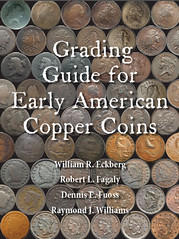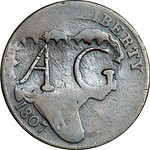
PREV ARTICLE
NEXT ARTICLE
FULL ISSUE
PREV FULL ISSUE
BOOK REVIEW: GRADING GUIDE FOR EARLY AMERICAN COPPER
Appropriately in time for this week's convention of the Early American Coppers Inc. (EAC), their new grading guide has popped to the top of my review stack. Since I'm no expert in the topic I'll keep my remarks from the bibliophile's perspective. The long-awaited book fully describes the process of grading early American copper coins as practiced by collectors who specialize in them. "EAC Grading" is distinct from, and typically more precise and stringent than grading by third-party grading services and auction houses. The book became available to EAC members at their convention in Colorado Springs, CO, May 1-4, 2014 and will be available to the public beginning tomorrow. The cover price is $54.95 plus $5 P&H. EAC or C4 members in good standing get a $5 discount. Members purchasing the book at the EAC convention will pay only $45. All proceeds from the book will go to EAC to support its educational and outreach activities. The rationale for EAC grading is laid out in the Introduction: Because copper coins were the money of the people and (unlike gold coins) were heavily used in commerce, because they are heavy and soft, and because copper is more reactive to oxidation than silver or gold, they received more wear and damage than early gold and silver coins. Because their relative value did not fluctuate like that of gold and silver coins, they were less subject to mass meltings during their time of circulation. Thus, many stayed in circulation until they were unrecognizable due to wear or corrosion. The different grading standards early copper specialists use from the commercial standards in the rest of US numismatics, and the different way they account for damage to coins from that used by the rest of numismatics adds an extra level of complexity and concern for those who might wish to collect these endlessly fascinating coins. This book addresses that complexity and concern by thoroughly describing the grading standards and processes used by specialists in the field and comparing them to the commercial standards and processes used in the rest of numismatics, with the goal of making copper collecting easier, more enjoyable and more fulfilling for all. Grades from About Good to Mint State (and higher Mint State grades, where such coins exist) of nearly all series are illustrated by full color photos twice the diameter of the coin.
The Introduction also provides a useful history of coin grading in the U.S., including the Sheldon numerical “Grades” from 1 to 70, Photograde, and the third-party grading services. Chapter 2 outlines the EAC Grading Guidelines, summarized as follows: An EAC grade usually consists of two grades. The first refers to the sharpness or degree of wear on the coin, i.e., the technical grade. The second is a net grade after accounting for any post-strike impairment(s) to the coin, i.e., the market grade. If there is a single grade, that means the coin has no significant impairments, and the net grade is the same as the sharpness grade. Commercial grading does not give separate sharpness and net grades, but provides a single overall grade. The full-color images are extremely helpful; a great example is the color set on pages 18-19.

Chapter 3 delves into Authentication, and the meat of the book is found in chapters 4-6 on the grading of Confederation Era Coppers, Half Cents and Large Cents. Confederation Era Coppers include New Jersey, Connecticut and Vermont coppers, Massachusetts Cents and Half Cents, and Fugio Cents. The Grading Guide easily passes my back-of-the-book test. Appendices beginning on p145 (of the 192-page book) constitute a full 25% of its content. Appendix I "provides some details pertaining to die clash, die breaks, and die state in the context of grading, for specific large cent varieties." These short notes, arranged by date and Sheldon variety, seem very useful, pointing out specific features and other diagnostic clues to varieties. Appendix II is a concise 3-page compilation of Photo Credits for the book's wonderful images, many of which are used courtesy of Ira and Larry Goldberg, Heritage Auctions, Stacks-Bowers Galleries, or individual collectors including Mike Packard, Neil Rothschild and Alan Weinberg. The ten-page Glossary is useful for far more than just grading, covering relevant numismatic terms from A-Z including Annealing, Cherrypick, Dentils, Die Clash, Medal alignment, Oxidation, Patina, Re-engraving Undertype, and Verdigris. And such early copper-specific terms such as Booby Head, Nichols Find, Silly Head, and Whist Match. Here's one example definition: Happening: a party or meeting at which specialists share particular coins and information about them; from the first Half Cent Happening, which took place in 1976 in Ann Arbor, MI. Such events are now held at every EAC Convention and are dedicated to colonials, half cents, large cents and bust silver coins And here's a term I don't think I'd heard before: Keg Mark: nick on the surface of a coin that could have resulted from contact with other coins in a keg that was used to store the coins before they went into circulation. QUICK QUIZ: without consulting the book, who can provide a definition for the term "Gynandroid" ? In summary, it's an easy call to highly recommend this book to any collector or dealer in early U.S. copper coins, as well as to general students of U.S. numismatics. There's a lot here for everyone to learn. Bill Eckberg informs me that over half of the print run has already been sold, so don't miss out - if you have any interest at all, order your copy soon.
For more information, or to order, see:
www.eacs.org
The Numismatic Bibliomania Society is a non-profit organization promoting numismatic literature. See our web site at coinbooks.org. To submit items for publication in The E-Sylum, write to the Editor at this address: whomren@gmail.com To subscribe go to: https://my.binhost.com/lists/listinfo/esylum All Rights Reserved. NBS Home Page Contact the NBS webmaster 
|

